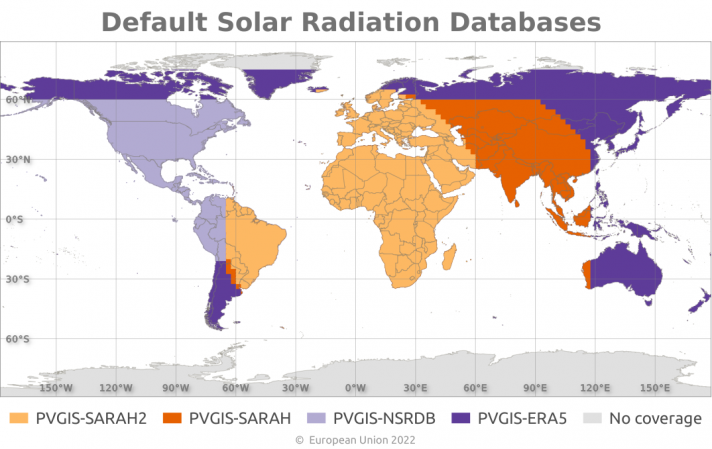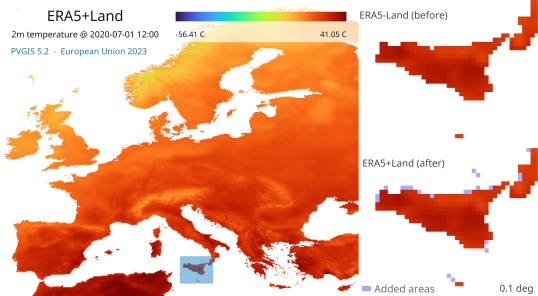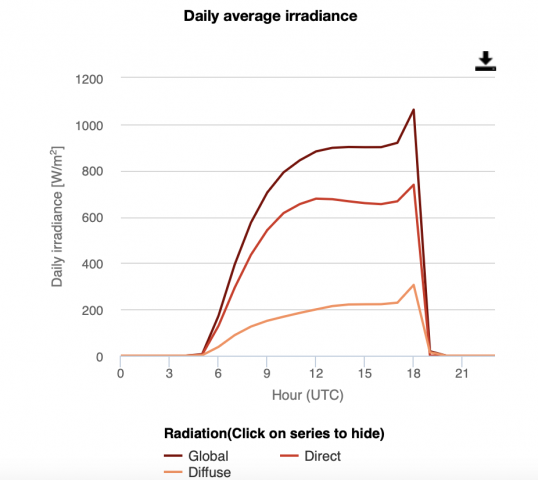New datasets
- The CMSAF solar radiation product SARAH-2.1 [1] (PVGIS-SARAH2) has been added to PVGIS with data from 2005 to 2020. SARAH-2 is the successor of the SARAH-1 surface radiation data record, which corresponds to PVGIS-SARAH in PVGIS 5.1. Users are strongly encouraged to use the new PVGIS-SARAH2 instead of PVGIS-SARAH, as it is a more up-to-date and better product. Furthermore, PVGIS-SARAH will be removed in the future.
- The ERA5 and ERA5-Land reanalysis products from ECMWF [2] now provides the climatic variables such as temperature, wind speed, wind direction, humidity, etc, whereas PVGIS 5.1 extracted these from ERA-Interim. ERA5 also provides irradiance values in areas where there is no coverage from satellite-based data sources.
- A validation of the new PVGIS-SARAH2 and PVGIS-ERA5 datasets with BSRN ground station data was published [3].
Default datasets
The new default radiation database is a combination of PVGIS-SARAH2 and PVGIS-SARAH (Europe, Africa, Central Asia), PVGIS-NSRDB (Americas) and PVGIS-ERA5 (Nordic countries above 60 N and the rest of the world).
Temporal coverage of the calculations (startyear, endyear)
The default data period for any calculations involving PVGIS-SARAH2 and PVGIS-ERA5 for the PV grid-connected, tracking PV, and PV off-grid tools is sixteen years, from 2005 to 2020. Customised time periods are possible with the “hourly data” tool or in calls from the non-interactive interface (API). The temporal coverage of PVGIS-SARAH (2005-2016) and PVGIS-NSRDB (2005-2015) is maintained as before.
API non-interactive interface calls
There's a dedicated API entry point for PVGIS 5.2: https://re.jrc.ec.europa.eu/api/v5_2/tool_name?param1=value1¶m2=value2&...
There's a also dedicated API entry point for PVGIS 5.1: https://re.jrc.ec.europa.eu/api/v5_1/tool_name?param1=value1¶m2=value2&...
The old entrypoint https://re.jrc.ec.europa.eu/api/tool_name?param1=value1¶m2=value2&... will continue to serve PVGIS 5.1 for the time being.
See the API support page for more info.
Graphic User Interface URLs
The standard PVGIS url https://re.jrc.ec.europa.eu/pvg_tools/en/tools.html will link to PVGIS 5.2 (users can then switch between the two version on the tool itself)
Alternatively the two versions can be accessed by specific urls:
https://re.jrc.ec.europa.eu/pvg_tools/en/#api_5.1
https://re.jrc.ec.europa.eu/pvg_tools/en/#api_5.2
COSMO and CMSAF datasets removed
As previously announced, the PVGIS-COSMO (2005-2015 data set) and PVGIS –CMSAF (originally developed for PVGIS4, now superseded) datasets have been removed from PVGIS 5.2.
Known Issues
- Update 17.2.2023 ERA5 with a spatial resolution of 0.5 degrees, has its rightmost border at 359.875 degrees. ERA5-Land datasets, produced by ECMFW, however, with a spatial resolution of 0.1 degrees, exceed the former minimally, ending at 359.950 degrees and only for pixels that are considered as land. Reminder that the latter product derives from the former after applying a fractional land-sea raster map as a mask. Hence, for pixels not included, according to the land-sea mask in question (in other words : for pixels considered to be sea) this rightmost column that exceeds the rightmost border of ERA5 data, is empty in ERA5-Land data. During the process to fill with values areas near coastlines, by merging ERA5-Land data on top of ERA5, these extreme cases still remains empty as there are no ERA5-Land values to fill-in with our new ERA5+Land dataset. So there are still a small number of pixels that remain unpatched between longitudes [-0.1,0] and near the coastlines.
- (Partially solved) In PVGIS 5.2 we extract climatic variables such as temperature, wind speed, wind direction, humidity and infrared radiation downwards from ERA5-Land. We have now seen that some areas on the coast can show values of these variables that are zero or close to zero (see the dark areas along the coast on map below to get an idea of the extent). This seems to be linked to pixels that are partially over water and therefore not classified as land. We are working on a solution to replace these values with those from ERA5. In the meantime, for the affected areas PV power generation will be higher than expected (since the temperature is zero). If you think a location you are looking at is affected by this, you can check the temperature values in the daily data tool.
- SOLVED We discovered some issues with tracking-mounting systems and the new irradiation data from PVGIS-ERA5, that causes some abnormal spikes towards the end of the day (as in the image below). The cause of this was an hour shift in the irradiation values from ERA5, which has now been solved.
References:
[1] Pfeifroth U., Trentmann J., Kothe S. Validation report Meteosat Solar Surface Radiation and Effective Cloud Albedo Climate Data Record. SARAH-2.1 climate data records (2019).
[2] Atmospheric Reanalysis ERA5 products. Copernicus Climate Change Service (C3S) at the European Centre for Medium-Range Weather Forecast.
Link to ECMWF ERA5 data documentation
[3] A.M. Gracia Amillo, N. Taylor, A.M. Martinez, E.D. Dunlop, P. Mavrogiorgios, F. Fahl, G. Arcaro, I. Pinedo, Adapting PVGIS to Trends in Climate, Technology and User Needs, Proc. 38th European Photovoltaic Solar Energy Conference and Exhibition, p. 907-911, DOI: 10.4229/EUPVSEC20212021-5BO.6.1




